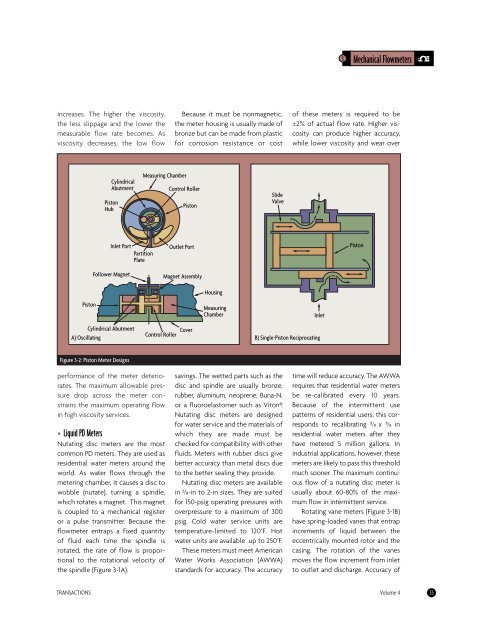flow and level measurement - Omega Engineering
flow and level measurement - Omega Engineering
flow and level measurement - Omega Engineering
You also want an ePaper? Increase the reach of your titles
YUMPU automatically turns print PDFs into web optimized ePapers that Google loves.
increases. The higher the viscosity,<br />
the less slippage <strong>and</strong> the lower the<br />
measurable <strong>flow</strong> rate becomes. As<br />
viscosity decreases, the low <strong>flow</strong><br />
Piston<br />
Cylindrical<br />
Abutment<br />
Piston<br />
Hub<br />
Figure 3-2: Piston Meter Designs<br />
Inlet Port<br />
Partition<br />
Plate<br />
Follower Magnet<br />
Cylindrical Abutment<br />
A) Oscillating<br />
Measuring Chamber<br />
performance of the meter deteriorates.<br />
The maximum allowable pressure<br />
drop across the meter constrains<br />
the maximum operating <strong>flow</strong><br />
in high viscosity services.<br />
• Liquid PD Meters<br />
Nutating disc meters are the most<br />
common PD meters. They are used as<br />
residential water meters around the<br />
world. As water <strong>flow</strong>s through the<br />
metering chamber, it causes a disc to<br />
wobble (nutate), turning a spindle,<br />
which rotates a magnet. This magnet<br />
is coupled to a mechanical register<br />
or a pulse transmitter. Because the<br />
<strong>flow</strong>meter entraps a fixed quantity<br />
of fluid each time the spindle is<br />
rotated, the rate of <strong>flow</strong> is proportional<br />
to the rotational velocity of<br />
the spindle (Figure 3-1A).<br />
Because it must be nonmagnetic,<br />
the meter housing is usually made of<br />
bronze but can be made from plastic<br />
for corrosion resistance or cost<br />
Control Roller<br />
Piston<br />
Outlet Port<br />
Magnet Assembly<br />
Cover<br />
Control Roller<br />
Housing<br />
Measuring<br />
Chamber<br />
savings. The wetted parts such as the<br />
disc <strong>and</strong> spindle are usually bronze,<br />
rubber, aluminum, neoprene, Buna-N,<br />
or a fluoroelastomer such as Viton®.<br />
Nutating disc meters are designed<br />
for water service <strong>and</strong> the materials of<br />
which they are made must be<br />
checked for compatibility with other<br />
fluids. Meters with rubber discs give<br />
better accuracy than metal discs due<br />
to the better sealing they provide.<br />
Nutating disc meters are available<br />
in L-in to 2-in sizes. They are suited<br />
for 150-psig operating pressures with<br />
overpressure to a maximum of 300<br />
psig. Cold water service units are<br />
temperature-limited to 120°F. Hot<br />
water units are available up to 250°F.<br />
These meters must meet American<br />
Water Works Association (AWWA)<br />
st<strong>and</strong>ards for accuracy. The accuracy<br />
B) Single-Piston Reciprocating<br />
3 Mechanical Flowmeters<br />
of these meters is required to be<br />
±2% of actual <strong>flow</strong> rate. Higher viscosity<br />
can produce higher accuracy,<br />
while lower viscosity <strong>and</strong> wear over<br />
time will reduce accuracy. The AWWA<br />
requires that residential water meters<br />
be re-calibrated every 10 years.<br />
Because of the intermittent use<br />
patterns of residential users, this corresponds<br />
to recalibrating L x I in<br />
residential water meters after they<br />
have metered 5 million gallons. In<br />
industrial applications, however, these<br />
meters are likely to pass this threshold<br />
much sooner. The maximum continuous<br />
<strong>flow</strong> of a nutating disc meter is<br />
usually about 60-80% of the maximum<br />
<strong>flow</strong> in intermittent service.<br />
Rotating vane meters (Figure 3-1B)<br />
have spring-loaded vanes that entrap<br />
increments of liquid between the<br />
eccentrically mounted rotor <strong>and</strong> the<br />
casing. The rotation of the vanes<br />
moves the <strong>flow</strong> increment from inlet<br />
to outlet <strong>and</strong> discharge. Accuracy of<br />
TRANSACTIONS Volume 4 35<br />
Slide<br />
Valve<br />
Inlet<br />
Piston

















